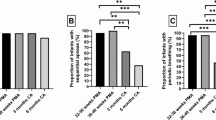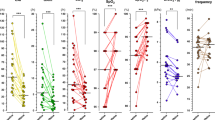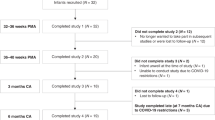Abstract
OBJECTIVE: This study examined the development of respiration during the preterm and early post-term periods and the effects of other biological and environmental variables, including sleep state, on this development.
STUDY DESIGN: Weekly 2-hour sleep observations and respiration recordings were obtained on 134 preterm infants from the time they were no longer critical until hospital discharge; a follow-up observation was conducted 1 to 3 months later.
RESULTS: All respiratory variables, except length of respiratory pauses in quiet sleep, decreased although the rate of this decrease slowed after term for four variables. Respiratory variables, except variability of respiratory pauses lengths and periodic respiration, differed by sleep state. Covariates, except methylxanthine treatment, had minor effects. Four variables showed hospital-related differences, but cisapride treatment helped to explain the differences in three variables.
CONCLUSIONS: Much development of respiration occurs in the early weeks after birth and reflects both neural maturation and effects of other biological and environmental factors, especially medications.
This is a preview of subscription content, access via your institution
Access options
Subscribe to this journal
Receive 12 print issues and online access
$259.00 per year
only $21.58 per issue
Buy this article
- Purchase on Springer Link
- Instant access to full article PDF
Prices may be subject to local taxes which are calculated during checkout




Similar content being viewed by others
References
Curzi-Dascalova L, Christova-Gueorguieva E . Respiratory pauses in normal prematurely born infants: a comparison with full-term newborns. Biol Neonate 1983;44:325–332.
Dua AD, Ralkar PR . Polygraphic recordings of respiration in neonates: a pointer to SIDS? J Postgrad Med 1997;43:61–63.
Glotzbach SF, Baldwin RB, Lederer NE, Tansey PA, Ariagno RL . Periodic breathing in preterm infants: incidence and characteristics. Pediatrics 1989;84:785–792.
Lee D, Caces R, Kwiatkowski K, Cates D, Rigatto H . A developmental study on types and frequency distribution of short apneas (3 to 15 seconds) in term and preterm infants. Pediatr Res 1987;22:344–349.
Parmelee A, Stern E, Harris M . Maturation of respiration in prematures and young infants. Neuropaediatrie 1972;3:294–304.
Patzak A, Schliter B, Mrowka R, et al. Rhythms and complexity of respiration during sleep in pre-term infants. Clin Physiol 1999;19:458–466.
Curzi-Dascalova L, Christova-Gueorguieva L, Lebrun F, Firtion G . Respiratory pauses in very low risk prematurely born infants reaching normal term. A comparison to full-term newborns. Neuropediatrics 1984;15:13–17.
Booth CL, Morin VN, Waite SP, Thoman EB . Periodic and nonperiodic sleep apnea in premature and fullterm infants. Dev Med Child Neurol 1983;25:283–296.
Curzi-Dascolova L, Bloch J, Vecchierrini MF, Bedu A, Vignolo P . Physiological parameters evaluation following apnea in healthy premature infants. Biol Neonate 2000;77:203–211.
Dittrichova J, Paul K . Respiratory patterns during sleep states in preterm infants. Act Nerv Super (Praha) 1989;31:213–214.
Ellingson RJ, Peters JF, Nelson B . Respiratory pauses and apnea during daytime sleep in normal infants during the first year of life: Longitudinal observations. Electroencephalogr Clin Neurophysiol 1982;53:48–59.
Holditch-Davis D, Edwards LJ, Wigger MC . Pathologic apnea and brief respiratory pauses in preterm infants: relation to sleep state. Nurs Res 1994;43:293–300.
Vecchierini MF, Curzi-Dascalova L, Ha TP, Bloch J, Gaultier C . Patterns of EEG frequency, movement, heart rate, and oxygenation after isolated short apneas in infants. Pediatr Res 2001;49:220–226.
Curzi-Dascalova L, Flores-Guevara R, Duidasci S, Korn G, Monod N . Respiratory frequency during sleep in siblings of Sudden Infant Death Syndrome victims. A comparison with control, normal infants. Early Hum Dev 1983;8:235–241.
Haddad GG, Jeng HJ, Lai TL, Mellins RB . Determination of sleep state in infants using respiratory variability. Pediatr Res 1987;21:556–562.
Manning DJ, Stothers JK . Sleep state, hypoxia and periodic breathing in the neonate. Acta Pediatr Scand 1991;80:763–769.
Waite SP, Thoman EB . Periodic apnea in the full-term infant: individual consistency, sex differences, and state specificity. Pediatrics 1982;70:79–86.
Barrington KJ, Finer NN, Wilkinson MH . Progressive shortening of the periodic breathing cycle duration in normal infants. Pediatr Res 1987;21:247–251.
Read DJC, Henderson-Smart DJ . Regulation of breathing in the newborn during different behavioral states. Ann Rev Physiol 1984;46:675–685.
Martin RJ, Herrell N, Pultusker M . Transcutaneous measurement of carbon dioxide tension: effect of sleep state in term infants. Pediatrics 1981;67:622–625.
Mok JYQ, Hak H, McLaughlin FJ, Pintar M, Canny GJ, Levison H . Effect of age and state of wakefulness on transcutaneous oxygen values in preterm infants: a longitudinal study. J Pediatr 1988;113:706–709.
Fewell JE, Baker SB . Arousal from sleep during rapidly developing hypoxemia in lambs. Pediatr Res 1987;22:471–477.
Sullivan CE . Breathing in sleep. In: Orem J, Barnes CD, editors, Physiology in Sleep. New York: Academic Press; 1980. p. 213–272.
Butcher-Puech MC, Henderson-Smart DJ, Holley D, Lacey JL, Edwards DA . Relation between apnoea duration and type and neurological status of preterm infants. Arch Dis Child 1985;60:953–958.
Di Flore JM, Arko MK, Miller MJ, et al. Cardiorespiratory events in preterm infants referred for apnea monitoring studies. Pediatrics 2001;108:1304–1308.
Hodgman JE, Gonzales F, Hoppenbrowers T, Cabal LA . Apnea, transient episodes of bradycardia, and periodic breathing in preterm infants. Am J Dis Child 1990;144:54–57.
Stefano JL, Anday EK, Davis JM, Fox WW, Spitzer AR . Pneumograms of premature infants: a study of longitudinal data. Am J Perinatol 1991;8:170–173.
Brazy J, Goldstein R, Oehler JM, Gustafson KE, Thompson RJ . Nursery Neurobiologic Risk Score: levels of risk and relationships with nonmedical factors. J Dev Behav Pediatr 1993;14:375–380.
Diong N, Lemke RP, Lin Y-J, Kwiatkowski K, Cates DB, Rigatto H . Airway closure during mixed apneas in preterm infants: is respiratory effort necessary? J Pediatr 1998;133:509–512.
Little GA, editor. Infantile apnea and home monitoring. Report of a consensus development conference. Bethesda, MD: National Institutes of Health; 1987. NIH 87-2905.
Ballard JL, Khoury JC, Wedig K, Wang L, Eilers-Walsman BL, Lipp R . New Ballard Score, expanded to include extremely premature infants. J Pediatr 1991;119:417–423.
Edwards LJ . Modern statistical techniques for the analysis of longitudinal data in biomedical research. Pediatr Pulmonol 2000;30:330–344.
Fairclough DL, Helms RW . A mixed linear model with linear covariance structure: a sensitivity analysis of the maximum likelihood estimators. J Statist Comput Simul 1986;25:205–206.
Holditch-Davis D, Edwards L, Helms R . Modeling development of sleep–wake behaviors: I. Using the mixed general linear model. Physiol Behav 1998;63:311–318.
Zeger SL, Liang KY, Albert PS . Models for longitudinal data: a generalized estimating equation approach. Biometrics 1988;44:1049–1060.
Weintraub Z, Alvaro R, Kwiatkowski K, Cates D, Rigatto H . Effects of inhaled oxygen (up to 40%) on periodic breathing and apnea in preterm infants. J Appl Physiol 1992;72:116–120.
Curzi-Dascalova L, Aujard Y, Gaultier C, Rajguru M . Sleep organization is unaffected by caffeine in premature infants. J Pediatr 2001;140:766–771.
Thoman EB, Holditch-Davis D, Raye JR, Philipps AF, Rowe JC, Denenberg VH . Theophylline affects sleep–wake state development in premature infants. Neuropediatrics 1985;16:13–18.
Sekar KC, Duke JA . Sleep apnea and hypoxemia in recently weaned premature infants with and without bronchopulmonary dysplasia. Pediatr Pulmonol 1991;10:112–116.
Dubin A, Kikkert M, Mirmaran M, Ariagno R . Cisapride associated with QTc prolongation in very low birthweight preterm infants. Pediatrics 2001;107:1313–1316.
Ward RM, Lemons JA, Molteni RA . Cisapride: a survey of the frequency of use and adverse events in premature newborns. Pediatrics 1999;103:469–472.
Kimball AL, Carlton DP . Gastroesphogeal reflux medications in the treatment of apnea in premature infants. J Pediatr 2001;138:355–360.
Halpern LF, MacLean WE, Baumeister AA . Infant sleep–wake characteristics: relation to neurological status and the prediction of developmental outcome. Dev Rev 1995;15:255–291.
Thoman EB . A biological perspective and a behavioral model for assessment of premature infants. In: Bond LA, Joffee JM, editors. Primary Prevention of Psychopathology: Facilitating Infant and Early Childhood Development. Vol. 6. Hanover, NH: University Press of New England; 1982. p. 159–179.
Acknowledgements
We thank Beth Black, Diane Hudson-Barr, Mary Barkey, Donna Harris, Tzu-Ying Lee, Leslie Miller, Jeanmarie Kanegan, Dawn Salerno, Tanya Kewson, Jason Dickenson, and Mark Johnson for technical assistance.
Author information
Authors and Affiliations
Additional information
The preparation of this paper was supported by Grant NR01894 from the National Institute for Nursing Research, National Institutes of Health.
Rights and permissions
About this article
Cite this article
Holditch-Davis, D., Scher, M. & Schwartz, T. Respiratory Development in Preterm Infants. J Perinatol 24, 631–639 (2004). https://doi.org/10.1038/sj.jp.7211150
Published:
Issue Date:
DOI: https://doi.org/10.1038/sj.jp.7211150
This article is cited by
-
What do we know about the sleep effects of caffeine used to treat apnoea of prematurity? A systematic review of the literature
Molecular and Cellular Pediatrics (2023)



